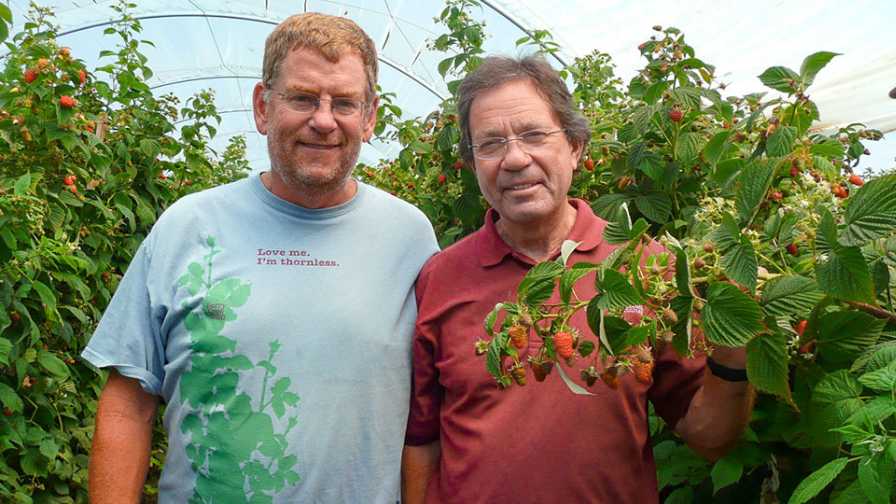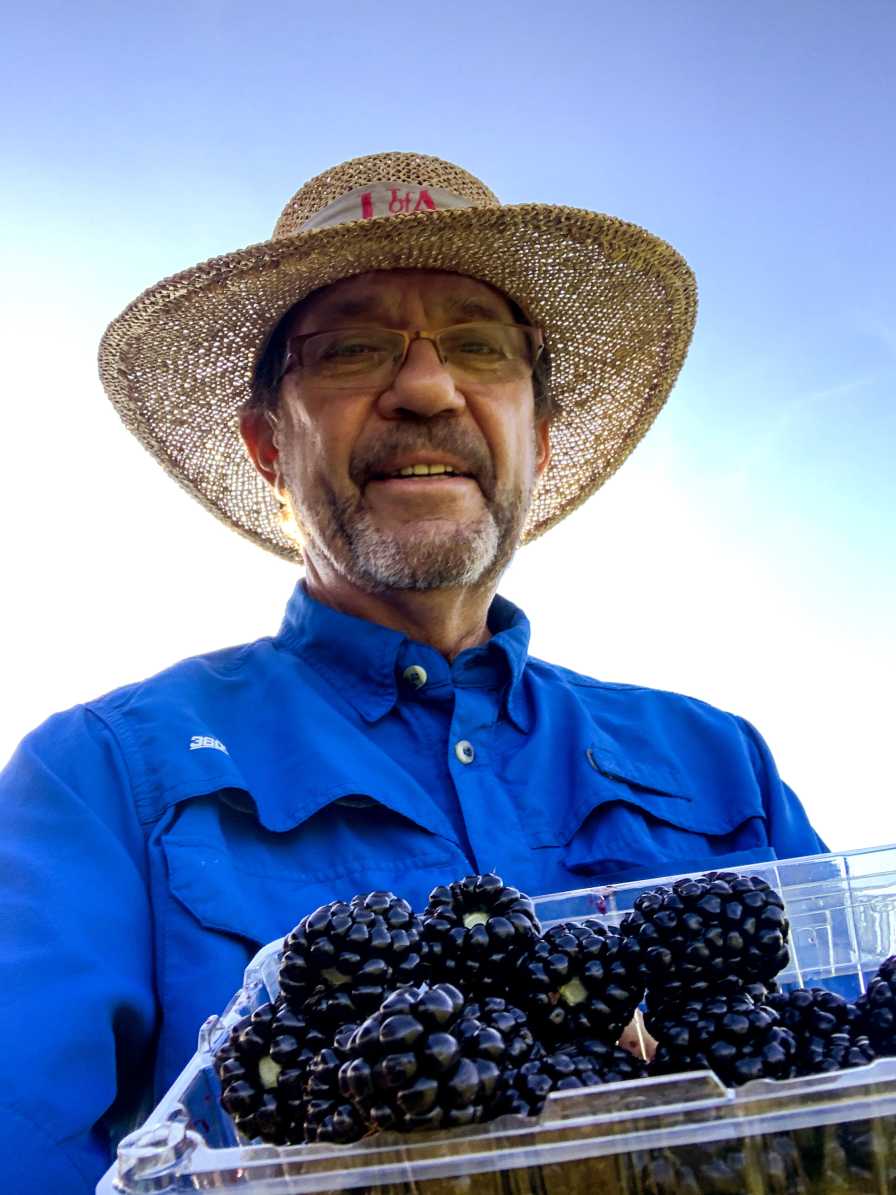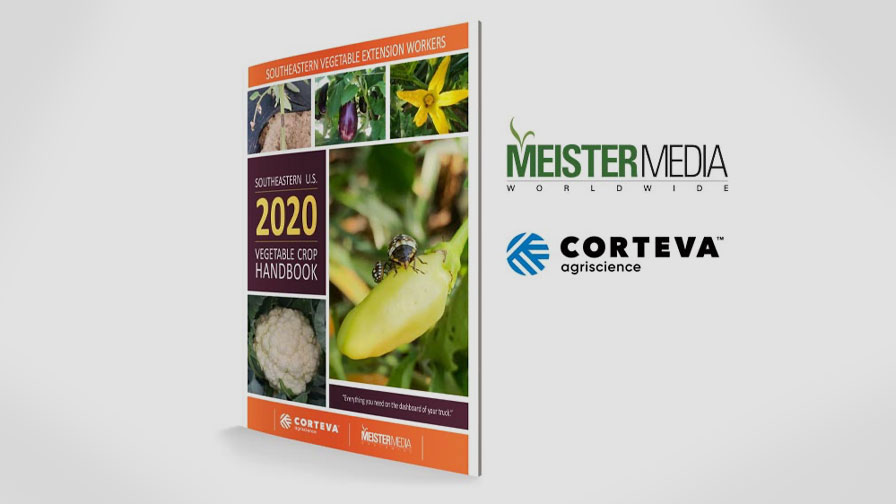My Tribute to a True Berry Breeding Legend and Friend

This moment in time captured legendary berry breeder Chad Finn (left) with fellow scientist and American Fruit Grower contributor John Clark in their element.
Photo by Ellen Thompson
When one thinks about legends, thoughts tend to move toward someone who is well known and possesses special qualities, talents, or abilities. Every field or subject area has its legends, and we have them in the small-fruit-breeding community, too.
When I think about legends in U.S. berry breeding, the first name that comes to mind is George Darrow, who improved a number of berry crops in his distinguished career with the USDA-ARS. Blueberry breeding legends include Frederick Coville, Arlen Draper, and Paul Lyrene, among others. Legendary caneberry breeders include George Slate, Hugh Daubeny, Jim Moore, and others. A number of legendary figures have improved strawberries, including a very talented group of California- and Eastern U.S.-based breeders. The list goes on.
Chad Finn is a legend in our time and someone dear to us all. He impacted everyone he met with his presence, words, and professional achievements; characteristics for all who become legends. Chad passed in mid-December, and the shock of his passing was felt around the world.
There are always facts to share about legends, and in the research world we do a lot of recording of items. Chad’s major career appointment was with the USDA-ARS as a small-fruit geneticist/breeder based in Corvallis, OR, from 1993 to 2019. Prior to that he was a Fruit Extension Specialist with the University of Missouri from 1989 to 1993. He attained his MS and Ph.D. degrees at the University of Minnesota, working with accomplished fruit breeder Jim Luby. His BS was from Purdue, and he grew up in Maryland just outside Washington DC. At his “Celebration of Life,” held in January in Corvallis OR, his family commented many times about his childhood love for gardening and the outdoors.
CHAD FINN’S MANY ACHIEVEMENTS
Paramount in Chad’s achievements were his developing or co-developing of more than 50 varieties of berries, including strawberries, blackberries, red raspberries, and blueberries. He worked with a number of other minor crops, including black raspberry and hardy kiwi, with noteworthy breeding accomplishments forthcoming from his efforts. He published hundreds of scientific articles across a range of publications. He generated millions of dollars in funding for his work in grants, royalties, and other sources of support. He was always in worldwide demand as a speaker, giving nearly 300 invited presentations.
Chad’s work helped growers under-stand how to increase profits, benefited consumers with great eating experiences, and inspired students, colleagues, and friends with wisdom, insight, charm, laughter, and joy. Everyone who knew Chad looked forward to the next chance to spend time with him. A key part of my calendar of activities each year included the places and times to see Chad. This is a good reminder to value the ephemeral nature of time and experiences in life.
One component of his magic was his spirit, which drove an enthusiasm, patience, discipline, lightness, and joy beyond that practiced by many. We spent a substantial amount of time working on breeding projects, cooperative writing, traveling, speaking, and simply having a big time. Every time I got frustrated with some endeavor we were pursuing, he always had the insight to pull us through to our intended destination, be it a completed book chapter or other publication, a scientific path of discovery, or an inspiring presentation.
Another part of his magic was his charm in relationships. I am not aware of him meeting anyone he could not have a positive conversation with. He is a true legend in his cooperative endeavors, multiplying his interactions with those around the world from how to grow a certain variety to developing molecular markers for innovative new breeding approaches.
One major and very impactful interaction we had was the testing of two primocane-fruiting blackberry selections from Arkansas. I had selected APF-8 and APF-12 in 1997, and in Arkansas they produced primocane berries that were small (about
2 g) and of very low quality — almost inedible. I thought they were worthless other than for use as parents in breeding. I even thought about throwing them away!
I sent these two selections to Chad in 2000 to test in the magical climate of Oregon. He took me to his test plots on Oct. 14, 2001 — a cool, misty fall day in the Willamette Valley. My eyes almost jumped out of my head! Instead of small, misshapen, marginal-quality berries, these plants bore large berries that were quite good quality and had huge yield potential. Perhaps even more substantial was that these berries were ripe in mid-October, a time when there simply were no domestic fresh blackberries in the market.
Our relationship, his cooperative nature, and his willingness to try new things were key to this substantial discovery. These selections went on to be named ‘Prime-Jim’ and ‘Prime-Jan’, the world’s first primocane-fruiting blackberries.
The key inspiration for this magic to be unveiled took place on that cool, misty day with Chad. Fortunately, Chad’s longtime collaborator and close friend, Bernadine Strik, and then-graduate student Ellen Thompson at Oregon State University, took these plants and conducted the foundational cultural research to reveal their true commercial potential. Primocane-fruiting blackberries have begun to change the world of blackberry production, and their impacts in the decades to come will lead to unbelievable stories of success in expanding the production of this berry.
A TRUE INSPIRATION
Chad routinely used the phrase in presentations that as plant breeders, “We build on foundations we did not lay.” In other words, we take what others have achieved genetically and then use these advancements to create the next generations of improvements. He provided an enormous foundation to build from. His breeding achievements will include not only the impact of the varieties he developed but also will lead to many additional varieties using his genetic advances as parents. His other scientific advances will be used by many.
For those who knew Chad, we will build on his foundational personal qualities — his enthusiasm, inspiring approach, positive attitude, and joyous approach to life.
If I need a lift, all I have to do is think of that famous Chad laugh — the laugh I like to say was heard ‘round the world. His jubilant personality, charm, and passion for breeding can be felt in the memorial YouTube video titled “Chad Finn Tribute 2020.” It’s guaranteed to make you smile.
These memories remind me of the berry-breeding legend of our time and inspire me to the next step on the road of life. Let the berry good times roll!










